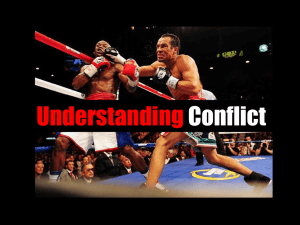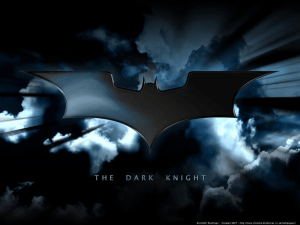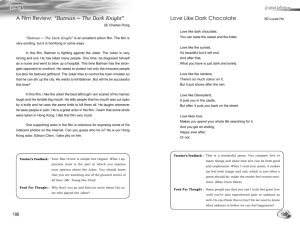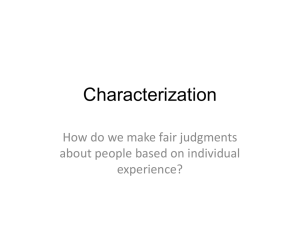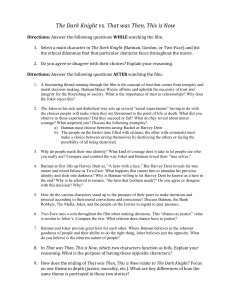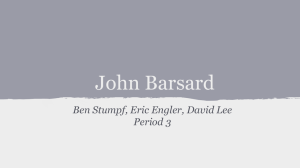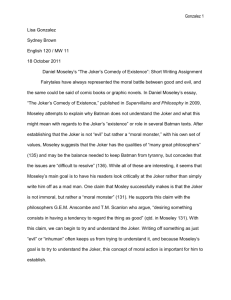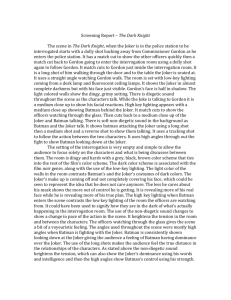AS90851 exemplar Describe at least ONE character or individual
advertisement
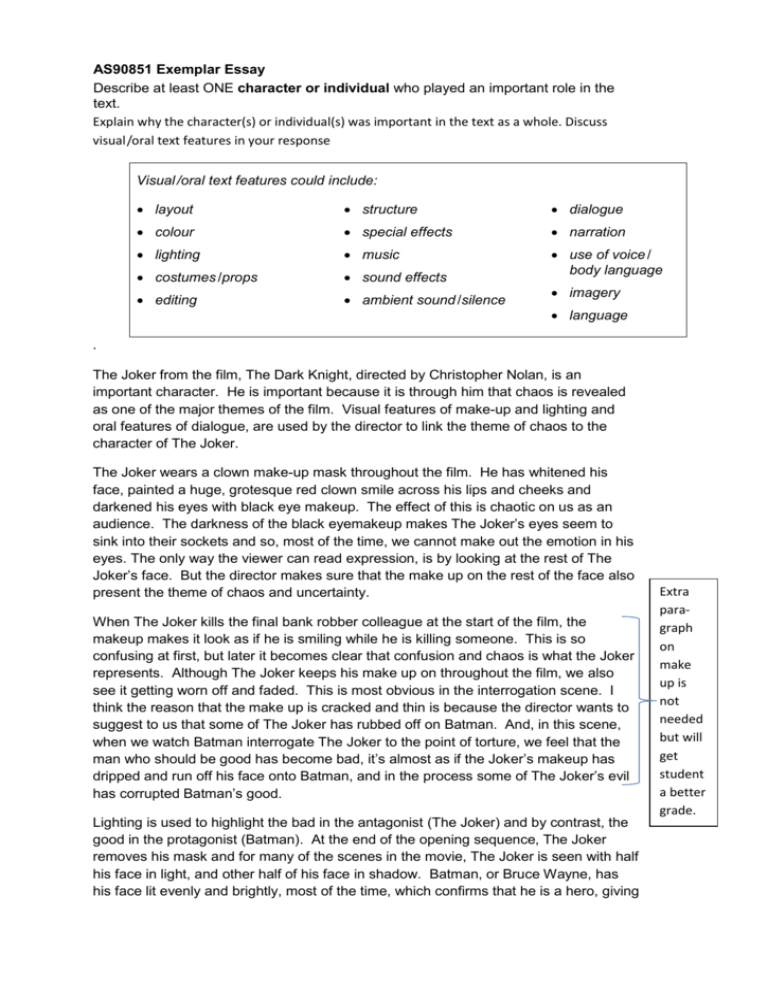
AS90851 Exemplar Essay Describe at least ONE character or individual who played an important role in the text. Explain why the character(s) or individual(s) was important in the text as a whole. Discuss visual /oral text features in your response Visual /oral text features could include: layout structure dialogue colour special effects narration lighting music costumes /props sound effects use of voice / body language editing ambient sound /silence imagery language . The Joker from the film, The Dark Knight, directed by Christopher Nolan, is an important character. He is important because it is through him that chaos is revealed as one of the major themes of the film. Visual features of make-up and lighting and oral features of dialogue, are used by the director to link the theme of chaos to the character of The Joker. The Joker wears a clown make-up mask throughout the film. He has whitened his face, painted a huge, grotesque red clown smile across his lips and cheeks and darkened his eyes with black eye makeup. The effect of this is chaotic on us as an audience. The darkness of the black eyemakeup makes The Joker’s eyes seem to sink into their sockets and so, most of the time, we cannot make out the emotion in his eyes. The only way the viewer can read expression, is by looking at the rest of The Joker’s face. But the director makes sure that the make up on the rest of the face also present the theme of chaos and uncertainty. When The Joker kills the final bank robber colleague at the start of the film, the makeup makes it look as if he is smiling while he is killing someone. This is so confusing at first, but later it becomes clear that confusion and chaos is what the Joker represents. Although The Joker keeps his make up on throughout the film, we also see it getting worn off and faded. This is most obvious in the interrogation scene. I think the reason that the make up is cracked and thin is because the director wants to suggest to us that some of The Joker has rubbed off on Batman. And, in this scene, when we watch Batman interrogate The Joker to the point of torture, we feel that the man who should be good has become bad, it’s almost as if the Joker’s makeup has dripped and run off his face onto Batman, and in the process some of The Joker’s evil has corrupted Batman’s good. Lighting is used to highlight the bad in the antagonist (The Joker) and by contrast, the good in the protagonist (Batman). At the end of the opening sequence, The Joker removes his mask and for many of the scenes in the movie, The Joker is seen with half his face in light, and other half of his face in shadow. Batman, or Bruce Wayne, has his face lit evenly and brightly, most of the time, which confirms that he is a hero, giving Extra paragraph on make up is not needed but will get student a better grade. the audience no reason to fear him and more reasons to side with him. In the interrogation scene, the director has the room darkened, with only one lamp shining upwards on the bottom of The Joker’s face. The director does this to show how chaotic things get when The Joker is around, because we all know that light normally comes from above, so to have it coming from below emphasises how upside down The Joker makes Gotham City. Later, when Batman is interrogating The Joker, the same flat, white light illuminates both of them. During this scene, and after this scene, Batman struggles to know how to behave in a way that is good and right, and I felt as if it was during this scene that the lighting used shows that both characters can be bad people. I felt really worried about this idea, because even though this is a fake, comic-book movie, I think that the idea of everyone having a chaotic mix of good and evil inside them is a scary idea. What if one day everyone allows the evil inside them to overwhelm the good – we will live in a world of anarchy and chaos! Extra paragraph on lighting is not needed but will get student a better grade. In the scene when The Joker threatens Rachel with a knife at a party, he says, “Now I’m always smiling” when he explains to her how he got his scars. His dialogue makes the viewer feel uneasy – having one’s face cut to create big scars, cannot be a happy memory, but The Joker makes out that it was a good thing, because it has left him with a scar that looks like a smile. Thus, his dialogue makes the theme of chaos clear. The tagline of the move is the question: “Why so serious?” and this is The Joker’s attitude all the way through the film. He loves conflict and says, “I’m an agent of chaos” – his words show us that it’s his goal to turn Gotham City upside down, eliminate law and order and show that the people of Gotham City are selfish, evil and savage. The most obvious way in which The Joker accomplishes his objective is via Harvey Dent. Dent’s dialogue early in the film “You either die a hero, or you live long enough to see yourself become the villain” foreshadows what becomes of him – he is transformed from Gotham’s White Knight into an evil and angry man by The Joker. Through dialogue, we realize The Joker lives for chaos and anarchy. Whenever he is around, we feel nervous about the questions that he asks, or the statements that he makes because nothing he says can be trusted. In The Dark Knight, the director Christopher Nolan manages to use dialogue, lighting and make-up to make us, the audience, hold a mirror up to our own faces and ask us to examine ourselves as human beings. We should come to the conclusion that we do not want to be unpredictable and irrational like The Joker, because engaging in that sort of behavior leads to chaos and destruction – and who wants to live in a world like that? Extra paragraph on dialogue is not needed but will get student a better grade.
